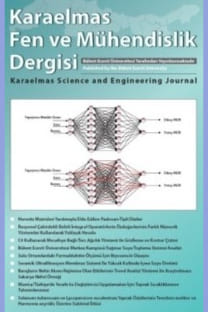AISI D2 ve AISI D3 Soğuk İş Çeliklerinin Delinmesinde İşleme Parametrelerinin Çapak Oluşumuna Etkilerinin Deneysel Olarak İncelenmesi
Bu çalışmada, Bilgisayarlı Sayısal Denetimli BSD freze tezgâhında boydan boya delik delme sürecinde değişen işleme parametrelerinin, delik sonu çıkışında çapak oluşumuna etkisi incelenmiştir. Deneysel çalışmalarda; iki farklı sertlikteki soğuk iş takım çeliği AISI D2, 20 HRC ve AISI D3, 28 HRC , iki farklı çap Ø 8 mm ve Ø 10 mm ve dört farklı uzunlukta HSS matkap uçlarıyla delinmiştir. Deneylerde üç farklı kesme hızı 5, 10 ve 15 m/dak ve üç farklı ilerleme hızı değeri 0.04, 0.05 ve 0.06 mm/dev değerleri kullanılmıştır. Deney sonuçlarına göre, ilerlemenin artmasına bağlı olarak delik sonu çapak yüksekliğinin azaldığı; delik sayısı, kesme hızı ve malzeme sertliğinin artmasına bağlı olarak da delik sonu çapak yüksekliğinin arttığı tespit edilmiştir
Anahtar Kelimeler:
İşlenebilirlik, HSS kesici takımlar, Delik delme, Çapak oluşumu
The Experimental Investigation of The Effect of Machining Parameters on Burr Formation in Drilling of AISI D2 and AISI D3 Cold Work Steels
In this study, the effect of changing processing parameters on the burr formation ats the exit end of hole during the drilling process in milling machines of CNC Computer Numerical Control was examined. . In experimental studies, cold work tool steels AISI D2, 20 HRC and AISI D3, 28 HRC were drilling by HSS cutting tools with four different lengths in two different diameters Ø 8 mm and Ø 10 mm . Three different cutting speeds 5 m/min, 10 m/min, 15 m/min and three different feed rates values 0.04 mm/rev, 0.05 mm/rev, 0.06 mm/rev were used in experiments. According to outcomes of the experiment, it was detected that burr height decreases depending on feed rates increase and burr height increases depending on the number of holes, cutting speed and material hardness.
Keywords:
Machinability, HSS cutting tools, Drilling Burr formation,
___
- Bahçe, E., Kılıçkap, E., Özel, C. 2010. Al-5005‟in Delinmesinde Delme Parametrelerinin Çapak Oluşumuna Etkisinin Araştırılması. 2. Ulusal Tasarım İmalat ve Analiz Kongresi, Sayfa. 242-250, 11-12 Kasım, Balıkesir.
- Chelladurai, H., Jain, VK., Vyas, NS. 2007. Development of a cutting tool condition monitoring system for high speed turning operation by vibration and strain analysis. Int. J. Adv. Manuf. Technol., 37: 471-485.
- Costa, ES., Silva, MB., Macdhado, AR. 2009. Burr Produced on the Drilling Process as a Function of Tool Wear and Lubricant- Coolant Conditions. J. Of Braz. Soc.Of Mech. Sci.&Eng., XXXI, 57-63.
- Fnides B., Aouici, H., Yallese, MA. 2008. Cutting forces and surface roughness in hard turning of hot work steel X38CrMoV5-1 using mixed ceramic. Mechanika, 2: 73-78.
- Kıvak, T. 2008. Inconel 718‟in delinebilinirliğinin araştırılması, Yüksek Lisans Tezi, Gazi Üniversitesi Fen Bilimleri Enstitüsü, Ankara.
- Kim, J., Dornfeld, DA. 2002. Development of an Analytical Model for Drilling BurrFormation in Ductile Materials. Transactions of the ASME, 124: 192-198.
- Mahfouz, IA. 2003. Drilling wear detection and classification using vibration signals and artificial neural network. Int. J. Mach. Tool. Manu., 43: 707– 720.
- Nouari, M., List, G., Girot, F., Gehin, D. 2005. Effect of machining parameters and coating on wear mechanisms in dry drilling of aluminium alloys. Int. J. Mach. Tool. Manu., 45: 1436-1442.
- Orhan, S., Er, AO., Camuşcu, N., Aslan, E. 2007. Tool wear evaluation by vibration analysis during end milling of AISI D3 cold work tool steel with 35 HRC hardness, NDT&E Int., 40: 121- 126.
- Özçatalbaş, Y. 2002. Kesici takım aşınması ve iş parçası pürüzlülüğü ve kesme kuvvetlerine etkisi. J. Politec. 4:, 47-52.
- Ramulu, M., Branson, T., Kim, D. 2001. A Study on the Drilling of Graphite / Bismaleimide Composite and Titanium stacks. Compos. Struc., 54: 67-77.
- Şahin, Y. 2003. İmal Usulleri, Gazi Kitapevi, Ankara, 248-259.
- Tonshoff, HL., Spintig, W., Konig, W., Neises, A.n Machining of holes developments in drilling techonolgy. CIRP Ann. Manuf. Techn., 43: 551-560.
- ISSN: 2146-4987
- Yayın Aralığı: 3
- Başlangıç: 2011
- Yayıncı: ZONGULDAK BÜLENT ECEVİT ÜNİVERSİTESİ
